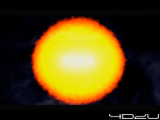Electromagnetic Radiation from Neutron Star Mergers
“Neutron stars” are one of the extreme types of celestial objects found in space. Although they have masses 1.4 times that of the Sun, their radii are only about 10 km, giving them an extremely high density of 1 trillion (10^12) kilograms per cubic centimeter. Interestingly, there are several binary systems which consist of two neutron stars, and sometimes these binary systems merge into a single object. This phenomenon is called a “neutron star merger”. Gravitational waves from neutron star mergers are one of the promising targets for next-generation gravitational-wave detectors, such as KAGRA.
The simulation presented here investigates the kinds of electromagnetic radiation (e.g. X-ray, visible light, radio waves) emitted from neutron star mergers. The simulation is an important step toward opening a new field of astronomy -- “multi-messenger astronomy” which combines electromagnetic wave and gravitational wave observations.

|
This animation is a visualization of a neutron star merger. Two neutron stars approach each other by emitting gravitational waves. Eventually, they merge and intense gravitational waves are emitted. Next-generation gravitational wave detectors aim to detect the gravitational wave from these kinds of catastrophic events. The mergers are also expected to emit electromagnetic waves. At the end of this scene, we move several dozen light-days away from the site of the merger to observe this phenomenon. |

|
This video shows the results of numerical simulations for a neutron star merger. Neutron star mergers eject part of the matter from the stars into interstellar space. New heavy elements are synthesized in this ejected material. The radioactive decay energy from the newly synthesized elements creates electromagnetic radiation. (An illustration of the explosion is inserted just after the merger.) |

| The ejecta have extremely high velocities, roughly 10-20% of the speed of light. Rapid expansion causes the density to decrease with time. About 15 days after the merger, the ejecta become almost transparent and do not emit electromagnetic waves any more. |

| This video visualizes the colors of the ejected materials. The colors change with the temperature of the ejecta. The emission spectrum from these materials peaks around red visible light and near infrared light. As a result, the emissions look "red" to our eyes. |

| This is an overhead view of the same simulations. Since neutron star mergers are highly asymmetric phenomena, we see brighter regions in the equatorial plane. |
Details of Numerical Simulation
| Purpose | Understanding electromagnetic radiation from neutron star mergers |
| Computer | Cray XC30 "ATERUI" |
| Time scale | 15 days |
| Spatial scale | Expanding from 1015 cm to 1016 cm |
| Researcher | Masaomi Tanaka (NAOJ) |
| Reference | Tanaka, M., & Hotokezaka, K., 2013, The Astrophysical Journal, 775, 113 |
Details of Visualization
In this movie, a binary system of neutron stars is shown schematically. Green is used to show the intensity of the light and we inserted an illustration of the explosion just after the merger. In the latter part of the movie, we show the Kelvin color temperatures approximated from the data for each cell in the simulation.
Credits
- Simulation: Masaomi Tanaka, Kenta Hotokezaka
- Visualization: Four-Dimensional Digital Universe Project, NAOJ
- Four-Dimensional Digital Universe Project, NAOJ
Release Information
- 2016.05 This web page was updated.
- 2014.03 Version 1.0 released.

1024x768, Windows Media Video
NSMergerRadiation1024x768.wmv (33 MB)
Other file formats ※If you want to use these file formats, please contact us.
1920x1080, Windows Media Video(3D,2D)
4096x4096, MP4 dome master (3D,2D)
4096x4096, PNG sequence dome master (3D,2D)